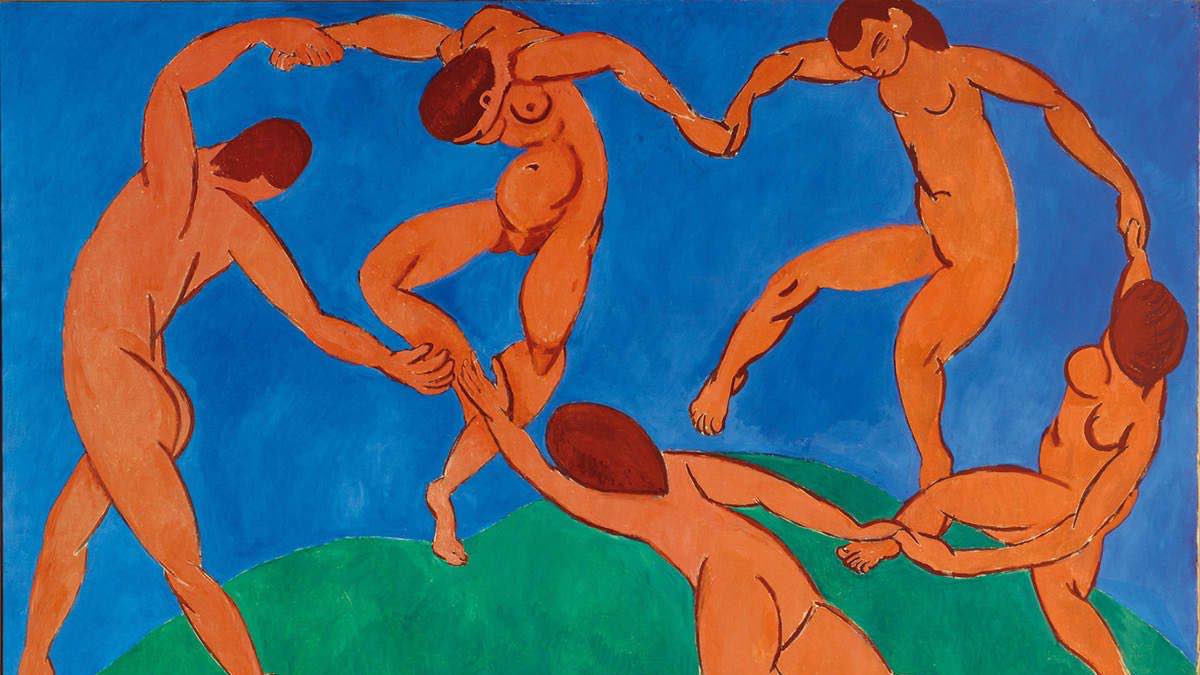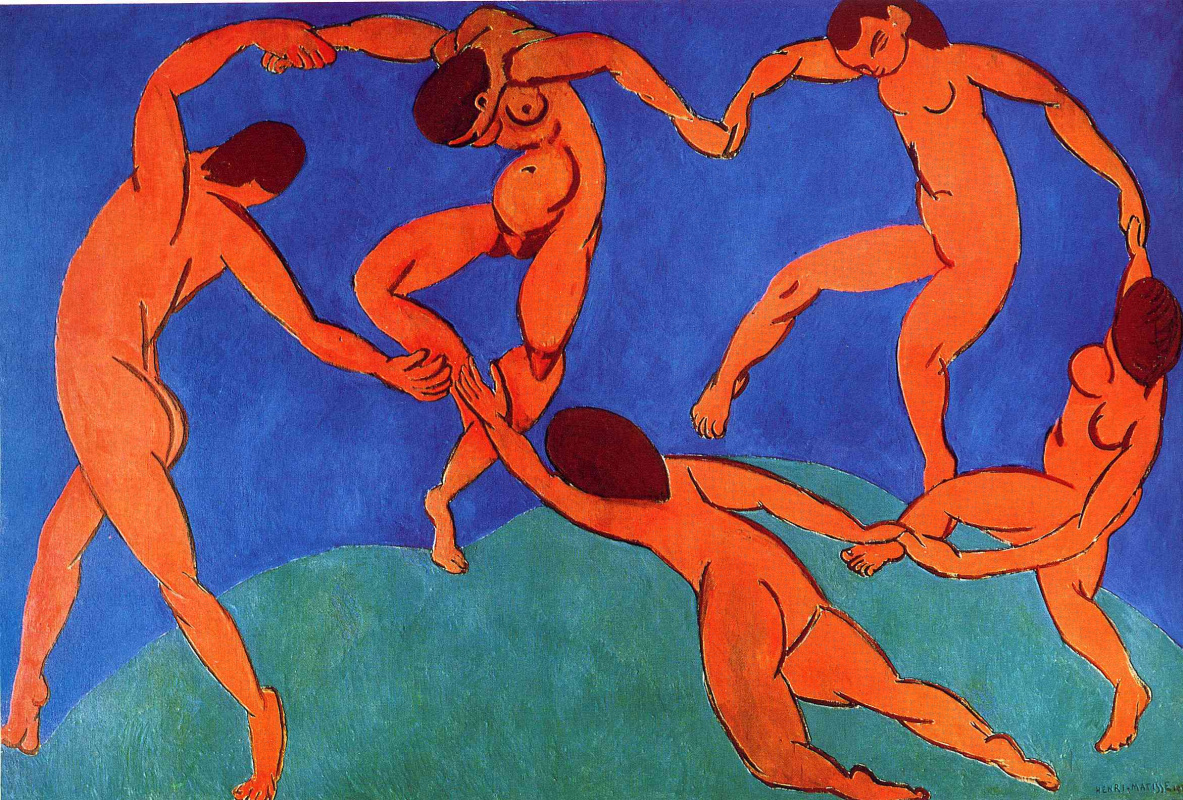
Art Analysis: Dance by Henri Matisse

Amongst Henri Matisse’s most famous works, Dance is an ode to life, joy, physical abandonment, and has become an emblem of modern art. The artwork was commissioned with its matching painting Music by the influential Russian collector Sergei Shchukin in 1909 for decorating his mansion. Characterized by its simplicity and energy, this ecstatic bacchanalia left a lasting mark on 20th-century art. Dance was painted at the height of the Fauvism aesthetic and embodies the emancipation from Western art’s traditional conventions of representation. Today, Dance by Matisse is hung with its partner Music at the Hermitage Museum in St Petersburg.
Fauvism’s saturated colours and candid style
Henri Matisse’s aesthetic choices for this painting caused quite a scandal in the 1910 art salons; the audacious nude and the crudely applied colours gave the artwork a primitive character which in the eyes of some viewers seemed barbaric. Matisse only used three colours for depicting this revelry: blue, green, and red. In line with Fauvism’s traditional colour associations, these three vivid hues create an intense contrast. Charles Caffin, an art critic who watched Matisse working on the canvas in his studio, stated that “the pigments were pure from the tubes.”
The economy of style and details produced ambiguous figures; neither their facial expression nor their gender is clearly defined. Red silhouettes are simply outlined with heavy contours against the blue and green background. Matisse explored the relationship between colours and lines to create harmony; for him, colours weren’t meant to work in isolation. Moreover, there are no architectural features or landscape markers to create a sense of perspective or distance. The huge canvas (260 cm by 391 cm) has a very flat background and the only focus are the dancing figures.
Primitivism and Fauvism

The Fauves shared primitivists’ interests in indigenous communities and they were inspired by primitivism to create art that returned to the essence of nature and communion. Dance’s crudely outlined figures recall primitivist styles and the subject matter, figures communing within an empty, perhaps “virgin” landscape, can be read as an advocation for a necessary reunification with nature. For example, the figure’s nakedness demonstrates a rejection of modern civilisation. The artwork becomes a symbol of unity between man, heaven and earth.
Matisse aimed to create a synthesis of primitivism; the clumsy figures inspired by primitive and folk art and bright energetic colours expressed instinct and nature. The individuals are entirely lost in their dance, oblivious to any daily obligations and work. Matisse does not focus on the dancers’ individual appearance, but rather on the movement and rhythm they create together. The dance is the ultimate symbol of the reconciliation of individuals.

The five figures are holding hands in a circle, but on the left, we can notice that the two individuals’ hands are parted; they only slightly brush instead of holding. However, Matisse carefully placed the rupture where it overlaps the other figure’s leg as not to break the colours and circle’s harmony. The rupture’s point being closest to the viewer’s position, it can be interpreted as an invitation to join in the dance. The circle comes to find those that “are outside,” and thus unify individuals.
Matisse and his fascination for dance

The theme of dance occupied an important place in Matisse’s life and work. Matisse first illustrated this interest in the 1906 painting Le bonheur de vivre (The Joy of Life). The dancers in Dance are in a similar position to the ones in the background of The Joy of Life. The motif visibly spiked Matisse’s interest enough for him to isolate it and dedicate an entire painting to exploring it. Still, according to the art critic Charles Caffin, the artist’s fascination with dance started at the Moulin de la Galette. There, he’d observe people dancing. This type of popular dancing contrasted with the more formal, traditional or classical types of dance such as ballet. In this regard, The Dance offers a reflection on the evolution of dance.
More specifically, the round dance that inspired the painting was a fishermen dance the artist observed in the Southern French city of Collioure. It was a version of the “Sardana,” a traditional Catalan farandole.
Matisse created movement with music
Despite the painting’s simplistic style, Matisse still developed a sense of movement and space within Dance. The endless sky and rounded shapes that forms the earth creates energy emanating from the rhythmical charged bodies. They seem to be in a trance. One can almost hear the beat of the drums and imagine a frenzied dance of the circled figures. The articulation of dance with music is essential as music creates its rhythm. In this regard, it is interesting to analyse Dance in parallel to its counterpart Music. The ongoing movement in Dance is in stark contrast with Music, where the figures are vertical and static. The singers almost look like spectators, gazing up at the dancers with their arms resting on their knees.
Breaking the rules

In Dance, Matisse completely abandoned the “Frenchman craftsmanship” for an aesthetic associated more closely to primitivism and with African art. He takes the distances himself from detail and finesse, as found in Edgar Degas’ work inspired by ballet. Matisse’s style is distilled it to its essence and ignores established rules of genre, aesthetic, harmony and order. Instead, his work is about a raw feeling and energy. He gives a freedom to colour and line that had rarely been seen before.
However, Matisse’s aim wasn’t to shock or embarrass the audience. Quite the opposite, he sought to reunify humans with each other and with nature. As the painter said; “What I dream of is a balanced, pure and quiet art which can avoid the trouble or frustrating subjects. This kind of art gives everyone’s mind peace and comfort, like a comfortable chair where they can have a rest when tired.” Although many viewers at the time couldn’t see past the daring style of the painting, today we can appreciate the work as an ode to life, joy and nature.

About Artsper
Founded in 2013, Artsper is an online marketplace for contemporary art. Partnering with 1,800 professional art galleries around the world, it makes discovering and acquiring art accessible to all.
Learn more













